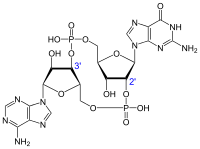Cyclic guanosine monophosphate–adenosine monophosphate
 | |
| Names | |
|---|---|
| Other names
cGAMP; cyclic GMP-AMP; cGAMP(2'-5'); cyclic Gp(2'-5')Ap(3'-5') | |
| Identifiers | |
| 849214-04-6 | |
| 3D model (Jmol) | Interactive image |
| PubChem | 71563406 |
| |
| Properties | |
| C20H24N10O13P2 | |
| Molar mass | 674.42 g·mol−1 |
| Except where otherwise noted, data are given for materials in their standard state (at 25 °C [77 °F], 100 kPa). | |
| Infobox references | |
Cyclic guanosine monophosphate–adenosine monophosphate (cyclic GMP-AMP, cGAMP) is the first cyclic di-nucleotide found in metazoa.[1] In mammalian cells, cGAMP is synthesized by cyclic GMP-AMP synthase (cGAS) from ATP and GTP upon cytosolic DNA stimulation.[2] cGAMP produced by cGAS contains mixed phosphodiester linkages, with one between 2'-OH of GMP and 5'-phosphate of AMP and the other between 3'-OH of AMP and 5'-phosphate of GMP.[3][4][5][6]
This molecule, referred to as 2′3′-cGAMP (cyclic [G(2’,5’)pA(3’,5’)p]) (it was mistakenly assigned as 3′3′-cGAMP (cyclic [G(3’,5’)pA(3’,5’)p]) in its discovery paper in 2012),[1] functions as an endogenous second messenger inducing STING-dependent type I interferon response.[1][3] cGAMP has also been shown to be an effective adjuvant that boosts the production of antigen-specific antibodies and T cell responses in mice.[7] cGAMP exercises antiviral functions in the cell where it is produced, but can also cross cell membranes by passive diffusion to exert effects on neighboring cells.[8] It may even be packaged into lentivirus (such as HIV-1), poxvirus and herpes virus, and under cell culture conditions has been found to transmit an antiviral signal to the cells infected with these viruses; however, there is reason to think that at least HIV is capable of evading this mechanism by some means.[8]
References
- 1 2 3 Wu, J; Sun, L; Chen, X; Du, F; Shi, H; Chen, C; Chen, ZJ (Dec 20, 2012). "Cyclic GMP-AMP is an endogenous second messenger in innate immune signaling by cytosolic DNA.". Science. 339 (6121): 826–30. doi:10.1126/science.1229963. PMID 23258412.
- ↑ Sun, L; Wu, J; Du, F; Chen, X; Chen, ZJ (Dec 20, 2012). "Cyclic GMP-AMP synthase is a cytosolic DNA sensor that activates the type I interferon pathway". Science. 339 (6121): 786–91. doi:10.1126/science.1232458. PMID 23258413.
- 1 2 Zhang, X; Shi, H; Wu, J; Zhang, X; Sun, L; Chen, C; Chen, ZJ (Jun 3, 2013). "Cyclic GMP-AMP Containing Mixed Phosphodiester Linkages Is An Endogenous High-Affinity Ligand for STING". Molecular Cell. 51 (2): 226–235. doi:10.1016/j.molcel.2013.05.022.
- ↑ Gao, P; Ascano, M; Wu, Y; Barchet, W; Gaffney, BL; et al. (May 3, 2013). "Cyclic [G(2′,5′)pA(3′,5′)p] Is the Metazoan Second Messenger Produced by DNA-Activated Cyclic GMP-AMP Synthase". Cell. 153 (5): 1094–1107. doi:10.1016/j.cell.2013.04.046.
- ↑ Ablasser, A; Goldeck, M; Cavlar, T; Deimling, T; Witte, G; Röhl, I; Hopfner, KP; Ludwig, J; Hornung, V (Jun 20, 2013). "cGAS produces a 2′-5′-linked cyclic dinucleotide second messenger that activates STING". Nature. 498 (7454): 380–384. doi:10.1038/nature12306.
- ↑ Diner, EJ; Burdette, DL; Wilson, SC; Monroe, KM; Kellenberger, CA; Hyodo, M; Hayakawa, Y; Hammond, MC; Vance, RE (May 23, 2013). "The innate immune DNA sensor cGAS produces a noncanonical cyclic dinucleotide that activates human STING". Cell Reports. 3 (5): 1355–61. doi:10.1016/j.celrep.2013.05.009. PMC 3706192
 . PMID 23707065.
. PMID 23707065. - ↑ Li, XD; Wu, J; Gao, D; Wang, H; Sun, L; Chen, ZJ (Sep 20, 2013). "Pivotal roles of cGAS-cGAMP signaling in antiviral defense and immune adjuvant effects". Science. 341 (6152): 1390–4. doi:10.1126/science.1244040. PMC 3863637
 . PMID 23989956.
. PMID 23989956. - 1 2 John W. Schoggins (2015-09-11). "Viruses carry antiviral cargo". Science. 349 (6253): 1186–1187. doi:10.1126/science.aad0942.